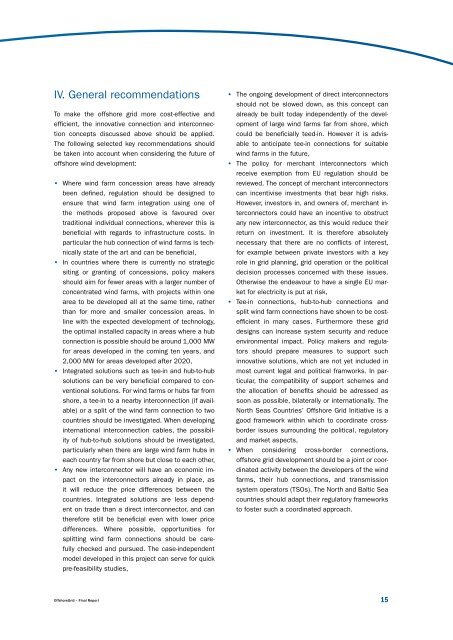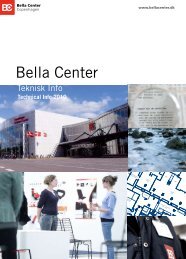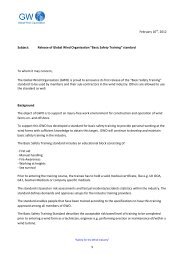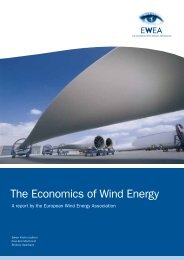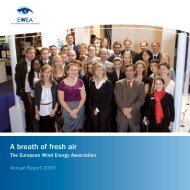Offshore Electricity Infrastructure in Europe - European Wind Energy ...
Offshore Electricity Infrastructure in Europe - European Wind Energy ...
Offshore Electricity Infrastructure in Europe - European Wind Energy ...
Create successful ePaper yourself
Turn your PDF publications into a flip-book with our unique Google optimized e-Paper software.
IV. General recommendations<br />
To make the offshore grid more cost-effective and<br />
efficient, the <strong>in</strong>novative connection and <strong>in</strong>terconnection<br />
concepts discussed above should be applied.<br />
The follow<strong>in</strong>g selected key recommendations should<br />
be taken <strong>in</strong>to account when consider<strong>in</strong>g the future of<br />
offshore w<strong>in</strong>d development:<br />
• Where w<strong>in</strong>d farm concession areas have already<br />
been def<strong>in</strong>ed, regulation should be designed to<br />
ensure that w<strong>in</strong>d farm <strong>in</strong>tegration us<strong>in</strong>g one of<br />
the methods proposed above is favoured over<br />
traditional <strong>in</strong>dividual connections, wherever this is<br />
beneficial with regards to <strong>in</strong>frastructure costs. In<br />
particular the hub connection of w<strong>in</strong>d farms is technically<br />
state of the art and can be beneficial,<br />
• In countries where there is currently no strategic<br />
sit<strong>in</strong>g or grant<strong>in</strong>g of concessions, policy makers<br />
should aim for fewer areas with a larger number of<br />
concentrated w<strong>in</strong>d farms, with projects with<strong>in</strong> one<br />
area to be developed all at the same time, rather<br />
than for more and smaller concession areas. In<br />
l<strong>in</strong>e with the expected development of technology,<br />
the optimal <strong>in</strong>stalled capacity <strong>in</strong> areas where a hub<br />
connection is possible should be around 1,000 MW<br />
for areas developed <strong>in</strong> the com<strong>in</strong>g ten years, and<br />
2,000 MW for areas developed after 2020,<br />
• Integrated solutions such as tee-<strong>in</strong> and hub-to-hub<br />
solutions can be very beneficial compared to conventional<br />
solutions. For w<strong>in</strong>d farms or hubs far from<br />
shore, a tee-<strong>in</strong> to a nearby <strong>in</strong>terconnection (if available)<br />
or a split of the w<strong>in</strong>d farm connection to two<br />
countries should be <strong>in</strong>vestigated. When develop<strong>in</strong>g<br />
<strong>in</strong>ternational <strong>in</strong>terconnection cables, the possibility<br />
of hub-to-hub solutions should be <strong>in</strong>vestigated,<br />
particularly when there are large w<strong>in</strong>d farm hubs <strong>in</strong><br />
each country far from shore but close to each other,<br />
• Any new <strong>in</strong>terconnector will have an economic impact<br />
on the <strong>in</strong>terconnectors already <strong>in</strong> place, as<br />
it will reduce the price differences between the<br />
countries. Integrated solutions are less dependent<br />
on trade than a direct <strong>in</strong>terconnector, and can<br />
therefore still be beneficial even with lower price<br />
differences. Where possible, opportunities for<br />
splitt<strong>in</strong>g w<strong>in</strong>d farm connections should be carefully<br />
checked and pursued. The case-<strong>in</strong>dependent<br />
model developed <strong>in</strong> this project can serve for quick<br />
pre-feasibility studies,<br />
<strong>Offshore</strong>Grid – F<strong>in</strong>al Report<br />
• The ongo<strong>in</strong>g development of direct <strong>in</strong>terconnectors<br />
should not be slowed down, as this concept can<br />
already be built today <strong>in</strong>dependently of the development<br />
of large w<strong>in</strong>d farms far from shore, which<br />
could be beneficially teed-<strong>in</strong>. However it is advisable<br />
to anticipate tee-<strong>in</strong> connections for suitable<br />
w<strong>in</strong>d farms <strong>in</strong> the future,<br />
• The policy for merchant <strong>in</strong>terconnectors which<br />
receive exemption from EU regulation should be<br />
reviewed. The concept of merchant <strong>in</strong>terconnectors<br />
can <strong>in</strong>centivise <strong>in</strong>vestments that bear high risks.<br />
However, <strong>in</strong>vestors <strong>in</strong>, and owners of, merchant <strong>in</strong>terconnectors<br />
could have an <strong>in</strong>centive to obstruct<br />
any new <strong>in</strong>terconnector, as this would reduce their<br />
return on <strong>in</strong>vestment. It is therefore absolutely<br />
necessary that there are no conflicts of <strong>in</strong>terest,<br />
for example between private <strong>in</strong>vestors with a key<br />
role <strong>in</strong> grid plann<strong>in</strong>g, grid operation or the political<br />
decision processes concerned with these issues.<br />
Otherwise the endeavour to have a s<strong>in</strong>gle EU market<br />
for electricity is put at risk,<br />
• Tee-<strong>in</strong> connections, hub-to-hub connections and<br />
split w<strong>in</strong>d farm connections have shown to be costefficient<br />
<strong>in</strong> many cases. Furthermore these grid<br />
designs can <strong>in</strong>crease system security and reduce<br />
environmental impact. Policy makers and regulators<br />
should prepare measures to support such<br />
<strong>in</strong>novative solutions, which are not yet <strong>in</strong>cluded <strong>in</strong><br />
most current legal and political framworks. In particular,<br />
the compatibility of support schemes and<br />
the allocation of benefits should be adressed as<br />
soon as possible, bilaterally or <strong>in</strong>ternationally. The<br />
North Seas Countries’ <strong>Offshore</strong> Grid Initiative is a<br />
good framework with<strong>in</strong> which to coord<strong>in</strong>ate crossborder<br />
issues surround<strong>in</strong>g the political, regulatory<br />
and market aspects,<br />
• When consider<strong>in</strong>g cross-border connections,<br />
offshore grid development should be a jo<strong>in</strong>t or coord<strong>in</strong>ated<br />
activity between the developers of the w<strong>in</strong>d<br />
farms, their hub connections, and transmission<br />
system operators (TSOs). The North and Baltic Sea<br />
countries should adapt their regulatory frameworks<br />
to foster such a coord<strong>in</strong>ated approach.<br />
15


